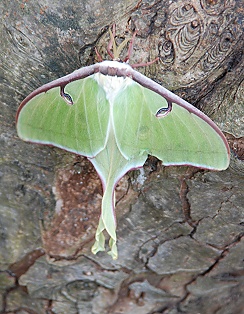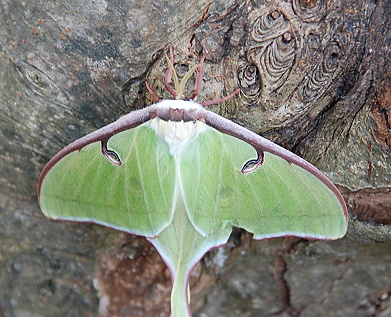We saw a Luna Moth again today. It might have been the same one or another one. This was in the mid-morning of a cloudy day, with a strong wind from the S (the other side of the fence.

Luna Moth
The white “frosting” on the forewing purple stripe is (when really enlarged) white scales mixed with the purplish ones. You can just see the underwing eyespots showing through.
The first time Richard spotted it, on Saturday evening, it was on a rusty blackhaw viburnum, a valuable native shrub that’s being eliminated from the area (along with every other bit of understory) on the grounds of being “brush”–the acreage across the highway from ours, for instance, has been scraped bare except for live oaks. Here’s our largest yard specimen, planted about twenty years ago:

Rusty Blackhaw Viburnum
It’s just opening its flower clusters; it’s beautiful in all seasons with shiny green leaves, the white flowers, blue berries that birds love, and shiny red leaves in the fall. One this size, if you could even find it in a nursery, would be worth over $500, and yet developers scrape them (and other valuable natives) off without a thought.
On a happier note, a final closer-up picture of the Luna Moth:

Luna Moth
The shading around the markings on the forewing makes them look three-dimensional.
Comment by AnnMCN — March 10, 2009 @ 4:44 am
Many years ago we had one on our back porch. It is a miraculous looking moth, as if created to inspire awe. Ooh – like in Charles Williams’ The Place of the Lion, an archetype.
Comment by gunhilda — March 10, 2009 @ 7:39 am
Beautiful!!!
Comment by elizabeth — March 10, 2009 @ 7:47 am
Oooh…someone else who’s read Charles Williams!
I got very lucky, is my thought, especially the bark behind the moth–that sort of face design looking back at it.
Comment by AnnMCN — March 10, 2009 @ 7:46 pm
You’ve read him, too? Cool! Hardly anyone seems to know of him.
I’m compulsive about attributing where I got an idea, hence the citation.
Comment by elizabeth — March 10, 2009 @ 9:09 pm
I haven’t re-read the books in years, so if an idea trickled up between the stones of my mind that started with him, I’m not sure I’d recognize it.
Some of it was brilliant…the visual images, the flashes of intensity, etc. On the whole I found some parts disturbing, despite the beauty, and gradually drifted away. But I’m glad I read his work, both fiction and nonfiction.
Comment by AnnMCN — March 11, 2009 @ 4:24 am
Some authors add to my mental furniture, maybe a concept, or a vivid scene, or people who exist. Williams had vivid images (the Butterfly archetype, for instance), but his main gift to me was the sense of the spiritual and material worlds being near each other, and interacting. Read his novels and poetry when I was in my twenties, and a reread or two later on.
Comment by elizabeth — March 11, 2009 @ 1:53 pm
That’s about the age I was reading Williams–probably late twenties through mid-thirties. I came back to Christianity at 25, after a long flirtation with neo-paganism. The extraordinary (to me, anyway) and unexpected means of return sent me out searching for things, and the progression from Chesterton & Sayers to include Tolkein, Lewis, and Williams was fast and furious. I always had the sense of the spiritual/numinous and the material being as close as two sides of a sheet of cellophane, if not simply intertwined, so that was familar and one of the things that attracted me.
Comment by AnnMCN — March 12, 2009 @ 5:12 am
I joined the Episcopal church during college; as a double major in theatre and English, liturgy fit me perfectly. During that time I did a lot of exploring in college (Tarot, seances, etc), but never left church. I have a lot of pagan friends now, in RL and online.
Let’s see, George MacDonald in grammar school, Tolkien and Lewis’ Space Trilogy in high school, then Narnia and more Tolkien in college, and then Sayers, Chesterton, Williams, and lots more Lewis. Oddly, I ran across them all independently of each other, except for Williams.
Modern Christianity seems to be very suspicious of the numinous, and I think that is one reason for the strength of neo-paganism.
Comment by elizabeth — March 12, 2009 @ 8:14 am
I’m really enjoying this discussion, but we’re wandering pretty far from wildlife, ecology, etc. For more theological stuff, consider my LJ or sff.net newsgroup–if you want, I can open a thread there.
To drag it back in the direction of this blog’s topic, I think it’s the reluctance of urbanized people (whether religious or not) to engage with the natural world–their fear of bugs, germs, weather, wildlife, etc–that sends those who *do* so engage, or want to–into all sorts of what were once fringe-groups. That and the urbanized overconfidence (on the other hand) that couches interactions in terms of triumphant human brilliance overcoming naughty Nature, or that ignores the reality of, for instance, bears because they’re “so cute.”
There are of course bugs, germs, weather, wildlife, etc. worth fearing–but lack of contact with anything wild produces unreasonable levels of fear on the one hand and overconfidence on the other. When people were closer to the land, they had a more realistic attitude–which included, for many, awareness of the Other, the numinous aspect.
The church where I sing on Sunday mornings has a Celtic service on Sunday afternoons; my friend K-, who died of cancer some years ago and whose horse I now caretake, was (in another parish) very attracted to the Celtic variant–in fact gave our adult class a lecture on it. The influence of “nature” in its widest sense on Celtic Christianity is very clear and very deep (historically and psychologically.) I think many people yearn for a connection with the land, some even without knowing it–they want it to be something more than ants at the picnic–but they don’t know how to get there.
Comment by AnnMCN — March 13, 2009 @ 5:07 am
Threadjacking. I am sorry! Have been enjoying too.
Back to nature. Yes! There’s a tendency to see it all as pretty Disney decoration, and then legislate against the inconveniences. People who move nest to the horse farm “Oooh, pretty” and then want zoning laws against the smell.
Comment by elizabeth — March 13, 2009 @ 8:11 am
No apologies necessary–I was doing it too. But in the more specific blogs I need to gently shunt discussions that wander too far to a more general discussion-lounge.
Amazing how many people want to live in the imaginary “country” of television: “Lassie’s” farm, for instance, where white-pawed collies never come in with muddy paws (and their belly fur and sides and tail heavy with mud and smelling of whatever they rolled in. I don’t have a collie now, but I did. Now I have a large palomino horse still in his winter coat, with a mane and tail. Who, after rolling, looks like a big mudball. His mane will be positively Rastafarian–mud dreadlocks with mud-ball decorations.
Must try to get out today and photograph the land after two days of rain. The yard trees are ecstatic and shoving their leaves out as fast as they can. No amphibians singing yet–it’s too cold (30s last night) for them. Richard said during one hard shower yesterday there was actually *moving* water in the near meadow–but slow enough it was clearing up between the meadow head (where it comes off a construction yard all turbid with road base) and the low end, where it runs off to a neighbor’s pasture.
Comment by AnnMCN — March 14, 2009 @ 7:16 am
I suppose it’s because so many people want an utterly predictable world, with no problems to solve, nothing unexpected. Even “reality” TV is formulaic. Nature, and the real world in general, does have patterns, but we cannot control it, not in the long run.
And, of course, this fear of the unexpected prevents happy surprises — your Luna moth would have been killed without ever being seen by someone who kept a bug zapper running.